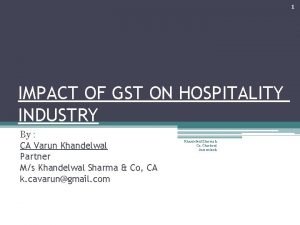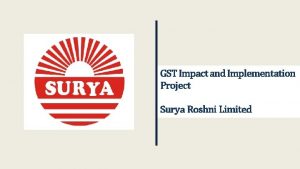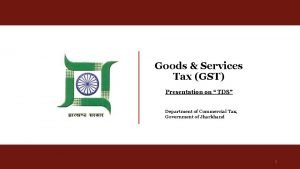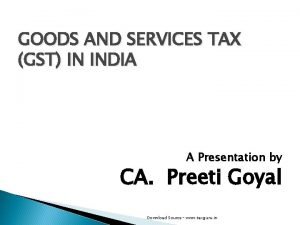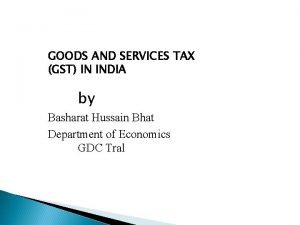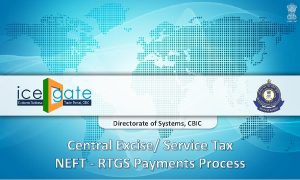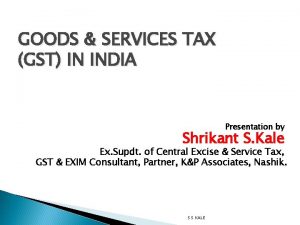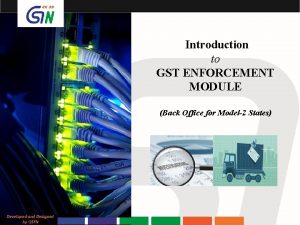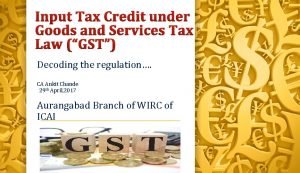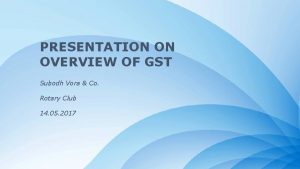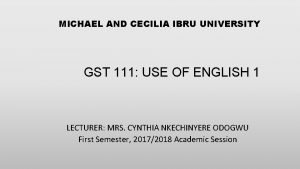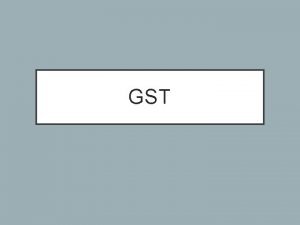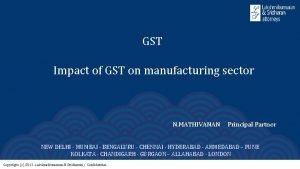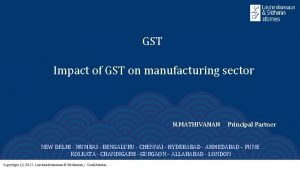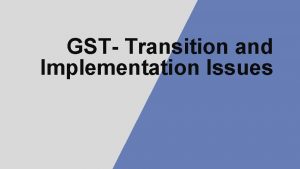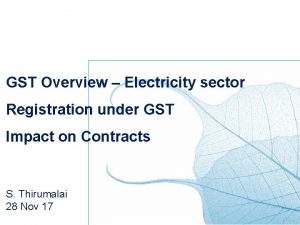IMPACT OF GST ON AUTO INDUSTRY GST play


















- Slides: 18


IMPACT OF GST ON AUTO INDUSTRY GST play a vital role in automobile industry. The recently finalized Goods and Services Taxes (GST) for automobiles are largely in line with expectations and broadly conform to the overall indirect tax rates currently in vogue. While the base GST rates for the automobile segment have been set at 28%, in addition to the base rate, the Government has also proposed to levy a cess on vehicles of different categories and sizes, the impact of which on the end prices of vehicles will vary accordingly.

AUTOMOBILE MEASURES & IMPACT MEASURES : § Cars will attract GST at the top rate of 28 per cent with a cess in the range of 1 to 15 per cent on top of it. § Luxury cars will attract 28 per cent GST plus cess of 15 per cent. § Small petrol cars will face 28 per cent plus 1 per cent cess, and small diesel cars 28 per cent GST plus 3 per cent cess. § Bigger cars’ cess is on expected lines, but the cess on small cars is a surprise for markets. § It is believed that the cess at 1 -3 per cent on small cars will be absorbed by the market as seen in the case of excise duties being increased by 2 per cent in the past. Current tax rates on small cars amount to around 29 per cent.

CONT. . . § Other automobile segments like two-wheelers are at 28 per cent rate which is slightly lower than the existing indirect tax rates on two-wheelers. Motorcycles with engines of more than 350 cc and above will attract 3 per cent cess. § However, the current tax incidence for Eicher Motors BSE 0. 08 % is 31 per cent and hence a 28 per cent GST plus 3 per cent cess will be neutral. § SUVs have a tax incidence of more than 40 per cent currently, so 28 per cent plus 15 per cent cess (43 per cent) is neutral for SUV manufacturers like M&M.

IMPACT : § Securities sees no major impact for four-wheeler auto stocks as the GST plus cess for most auto segments is closer to the existing indirect tax rates. § While for two-wheeler stocks, the rate is slightly below the indirect tax rate, although in line with expectations of 28 per cent tax rate. § we expect small to mid-segment cars to be impacted which in turn could translate into a gain for the two-wheeler segment. ” So the Eicher motors get benefit from the two wheeler segment after GST. Under GST, most of the two-wheelers will attract a tax rate of 28%, lower than total tax incidence of around 30% at present.


GST ON TWO WHEELERS BEFORE GST AFTER GST Engine size below 350 cc 30. 2% 28% Engine Size More Than 350 cc 30. 2% 31%

§ The classification of two-wheelers has been done in two types, those with the engine capacity of less than 350 cc and those with greater than 350 cc. § A total of 30. 2 percent tax, which includes Excise Duty at 12. 5 percent, NCCD at one percent (National Calamity Contingency Duty), VAT at 12. 5 percent (Value Added Tax) and CST two percent (Central Sales Tax) brings the total tax rate to 30. 2 percent. After the implementation of GST, two-wheelers less than 350 cc would incur a tax of 28 percent while those higher than 350 cc would be subjected to around 31 percent tax. So, while a Royal Enfield Classic 350 would cost less, a Classic 500 might become more expensive. § That said, the difference in the new tax scheme would not be significant and hence will not affect the buying sentiment of the sector in the long-run.


COMMERCIAL VEHICLES BEFORE GST AFTER GST Commercial Vehicles 30. 2% 28% Buses with 10 to 13 passengers capacity 30. 2% 43% Three Wheelers 29. 1% 28%

§ The commercial vehicle category is classified into two parts, commercial vehicles and three-wheelers. § The tax structure before the implementation of GST officially includes 12. 5 percent Excise Duty, one percent NCCD, 12. 5 percent VAT and two percent CST bringing it to a total of 30. 2 percent for the commercial vehicle category. § Three-wheelers are not taxed for NCCD, which means a total of 29. 2 percent tax is levied on them. With the implementation of GST, a new category for buses which can ferry up to 13 passengers would also be introduced. § The new tax structure would mean that commercial vehicles would see a small dip of 2. 2 percent from 30. 2 percent to 28 percent.

§ Three-wheelers would witness a slight reduction of 1. 1 percent from 29. 1 percent to 28 percent. § The new category of buses that can ferry up between 10 and 13 passengers incurs a total effective tax of 30. 2 percent right now and will now witness a considerable jump with the new tax structure to 43 percent. § Overall, the commercial vehicle sector will stay unaffected and potential buyers of buses with load carrying capacity of 10 to 13 passengers would see a considerable rise of 12. 8 percent tax.


PASSANGER VEHICLES (Four Wheelers) BEFORE GST AFTER GST BASE RATE CESS EFFECTIVE RATE Small Cars Below 4 meters (petrol) 31. 4% 28% 1% 29% Small Cars Below Four Meters (Diesel) 33. 4% 28% 3% 31% Mid-Size Cars more than 4 meters but less than 1500 cc 46. 6% 28% 15% 43% Bigger Cars More than 4 meters & 1500 cc 51. 8% 28% 15% 43% SUVs 55. 3% 28% 15% 43% Hybrid 30. 3% 28% 15% 43%

§ This category has the most number of segregations based on length of a vehicle as well as engine capacity. The pre-GST tax structure included Excise Duty, NCCD, Infra Cess, CST and VAT. § Sub-4 meter petrol cars, which were taxed at about 31 percent, would incur 29 percent tax, while their diesel counterparts would incur 31 percent after the implementation of GST as opposed to roughly 33 percent. This would translate into a small change for the small car buyer, which won't have any impact on the overall buying mood. § Mid-sized cars that are above four meters in length but less than 1, 500 cc in engine capacity, as well as cars with more than 1, 500 cc engine capacities, will witness a considerable dip.

GST IMPACT ON MARUTI SUZUKI : MODEL PRE GST POST GST Maruti Suzuki Alto 800 Rs. 2. 51 lakh to Rs. 3. 76 lakh Rs. 2. 46 lakh to Rs. 3. 70 lakh Maruti Suzuki Ignis Rs. 4. 59 lakh to Rs. 3. 70 lakh Rs. 4. 50 lakh to Rs. 7. 70 lakh Maruti Suzuki Vitara Brezze Rs. 7. 26 lakh to Rs. 9. 66 lakh Rs. 7. 22 lakh to Rs. 9 lakh Maruti Suzuki Ciaz Rs. 7. 73 lakh to Rs. 10. 52 lakh Rs. . 7. 45 lakh to Rs. 10. 24 lakh

§ Due to the Goods & Services Tax or GST impact, Maruti Suzuki announced a price drop of up to 3 per cent on selected models. § The price drops range from Rs 2, 300 to Rs 23, 400 depending on the size of the car and the variant that is selected. § After the tax structure was announced, it has reduced prices of cars in all segments. Although, the price cuts vary through the different categories where cars are listed and accordingly, taxes are levied. § The Indian automotive industry had its expectations in the positive side of things where prices of cars would reduce. Maruti Suzuki gets a good impact while cut in tax the price of the cars are reduced and the customer are more attract to use, and there is growth in profit & income after implementation of GST.

 Impact of gst on hotel industry pdf
Impact of gst on hotel industry pdf Impact of gst on construction industry
Impact of gst on construction industry Typewriter types
Typewriter types Gozago
Gozago I've got a friend we like to play we play together
I've got a friend we like to play we play together Louise made the chocolate cake active or passive
Louise made the chocolate cake active or passive Password for e-way bill
Password for e-way bill Negative list of gst
Negative list of gst Gst em signer error link
Gst em signer error link Conclusion on gst
Conclusion on gst Annexure b for gst refund
Annexure b for gst refund What is gst
What is gst Cbicpay
Cbicpay Importance of gst
Importance of gst Gst law enforcement
Gst law enforcement Section 18(1)(c) of gst
Section 18(1)(c) of gst Gst ppt template
Gst ppt template Gst 111
Gst 111 Gst rates on services pdf
Gst rates on services pdf
